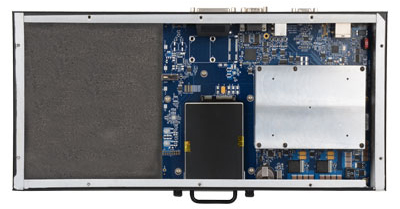Improve System Reliability by Eliminating Cables with a Computer-On-Module Design

Using a traditional SBC form factor like EBX or PC/104 in an industrial computer requires cabling signals from the boards video, Ethernet, USB and serial ports to external connectors in the enclosure. Likewise, the hard drive is connected with data and power cables.
COM architecture allows the custom carrier board to be designed to the exact mechanical dimensions with I/O connectors soldered directly to the custom carrier board allowing external access without any internal cables. Eliminating cables increases reliability not only in high vibration and high shock design, but any system design since cable connections can easily shake loose during transit. Take a look at the differences in the two systems below.
EBX-based System
The first image shows the original design using an EBX SBC and carrier board. The EBX design required multiple internal cables that had to be routed inside the enclosure.
COM Express System
The second image shows a Sealevel COM Express design with a custom carrier board that completely eliminates all internal cables. Even the solid-state drive was secured to the carrier board, preventing failures from shipping or other sources of vibration.
Our engineers will work with your team from conception to completion on all custom product development to ensure a perfect fit for your application. Contact us today to discuss your application for a COM Express system.

